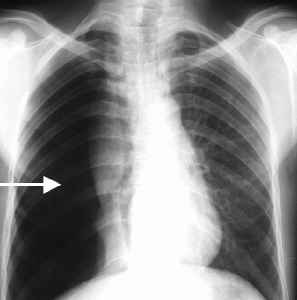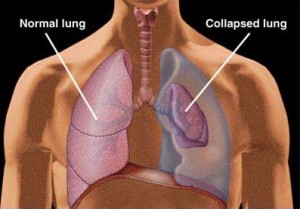Are you suffering from painful sensations in your chest as you try to breathe fully during a workout or even a hectic activity for a short period? If yes, you could be suffering from a condition known as Collapsed lung. Know all about the disorder, including its various possible causes, symptoms, diagnosis and treatment options.
Collapsed lung Definition
Page Contents
- 1 Collapsed lung Definition
- 2 Collapsed lung ICD9 Code
- 3 Collapsed lung Symptoms
- 4 What Causes a Collapsed lung?
- 5 What is Partial Pneumothorax?
- 6 What is Tension Pneumothorax?
- 7 What is Traumatic Pneumothorax?
- 8 What is Spontaneous Pneumothorax?
- 9 Collapsed lung Risk Factors
- 10 Collapsed lung Diagnosis
- 11 Collapsed lung Differential Diagnosis
- 12 Collapsed lung Treatment
- 13 Collapsed lung Prognosis
- 14 Collapsed lung Recovery
- 15 Collapsed lung Rehabilitation
- 16 Collapsed lung Complications
- 17 Collapsed lung Prevention
- 18 Collapsed lung Pictures
It is a condition caused by the buildup of air in the space surrounding the lungs. This accumulated air exerts pressure on the lungs, making its unable to expand normally while breathing. Patients find it painful to respire as a result.
The disorder is medically referred to as “Pneumothorax.”However, the term is also used sometimes to refer to Atelectasis, a collapse of the lung sacs that contain air.
The disorder is also known by various other names, such as:
- Air around the lung
- Air outside the lung
- Spontaneous pneumothorax
Collapsed lung ICD9 Code
The ICD9 Code for this disorder is 518.0.
Collapsed lung Symptoms
The condition is typically manifested by the following problems:
- Respiratory shortness
- Acute chest pain, worsened due to coughs or deep breathing
- Nasal flaring (rare)
Patients may also experience various other symptoms in case of a large pneumothorax, such as:
- Tightness of chest
- Tiredness, even without much exertion
- Rapid heart rate
- Bluish discoloration of skin, resulting from oxygen deficiency
In most cases of this condition, only one lung is found to be affected.
What Causes a Collapsed lung?
The condition arises when air escapes from the lungs and gets accumulated in the space external to the lungs but within the chest. This may result from any of the following factors:
- Rib fracture
- Damage caused by an underlying lung disorder
- A chest wound caused by a knife or gunshot
- Certain medical techniques
In some individuals, the condition may arise even in the absence of any visible causes. This is known as a spontaneous Pneumothorax. In this type of the condition, a small, air-filled lung area can suffer a rupture and send air into the space surrounding the lungs.
What is Partial Pneumothorax?
Also known as Partial Lung Collapse, it is a condition caused by part of a lung due to obstruction of the air passages or as a result of extremely shallow breathing. In adults, small areas of a partially collapsed lung are not generally life-threatening. This is due to the reason that the unaffected lung regions tend to compensate for the lack of function in the affected area. However, large-scale collapse of this type may be fatal – particularly in individuals who have another lung disorder or suffer from some other ailment. In infants and small children, lung collapse occurring as a result of mucus obstruction or some other factors may give rise to life-threatening problems. The condition may also lead to the development of Pneumonia.
A partial collapse of lung is also referred to as Atelectasis.
What is Tension Pneumothorax?
It is a particular form of Lung collapse in which air gets inside the space around the lungs and fails to escape the region completely. With each breath, greater amount of air is inhaled. In such conditions, patients suffer from severe chest pain and respiratory shortness which may worsen rapidly as the contents of the chest and the lung are compressed. This is a medical emergency and needs to be treated on an urgent basis.
What is Traumatic Pneumothorax?
In this form of the disorder, air may also enter the pleural space from outside the body. This may occur as a result of injuries marked by penetration of the chest by stabbing, broken ribs or surgeries performed on the chest.
What is Spontaneous Pneumothorax?
In this type of Pneumothorax, air commonly enters the space around the lungs when a bulla (a small air sac located on the lung surface) that is present from birth suffers a tear. The rupture may be caused by vigorous exercise, letting air escape into the lungs.
Collapsed lung Risk Factors
The condition has been found to affect certain people more than others. This at-risk group includes smokers and individuals having a tall, thin build.
The risk of having the condition is also elevated for people suffering from any of the following disorders:
- Whooping cough
- Asthma
- COPD
- Tuberculosis
Other risk factors for the disorder include:
Being male
Men are at greater risk of developing this disorder than women.
Being young
People aged between 20 and 40 years are more susceptible to rupture of air blisters, which can result in Pneumothorax.
History of the disorder
Those with a history of the condition, generally within 1-2 years of the first episode, are more likely to suffer from a recurrence of the disease. The condition may affect the same or the opposite lung.
Heredity
The disorder is also found to run in members or generations of same families.
Having certain lung disorders
The presence of an underlying disorder, particularly cystic fibrosis, sarcoidosis, pulmonary fibrosis or emphysema can make an individual more likely to suffer from a lung collapse.
Mechanical ventilation
Individuals who require mechanical ventilation for effective respiration are at an elevated risk of having thois condition.
Collapsed lung Diagnosis
A physical examination is often enough to detect this condition. A stethoscope exam helps reveal absence or reduction of breathing sounds on the side of the chest that is affected. Patients may also suffer from low blood pressure due to the condition. This happens due to the reason that the high pressure caused by trapped air prevents return of blood to the heart from the lungs.
Other diagnostic tests for the disorder include:
- Chest x-ray
- Arterial blood gases
A chest x-ray is usually the first medical test that is used to detect a Pneumothorax. In certain cases, CT (Computerized Tomography) scans may be required to obtain more detailed images of the lung space. CT scans are a combination of X-ray images taken from various directions to create cross-sectional views of the internal structures.
Collapsed lung Differential Diagnosis
The differential diagnosis of this condition involves distinguishing its signs from similar symptoms produced by other disorders, such as:
- Asbestosis
- Ascites
- Acute or chronic lung disease
- Blunt chest trauma
- Diaphragmatic paralysis
- Cancer or abscess of the lung
- Pneumothorax
- Pleural effusion
- Pneumonia
- Pulmonary embolism
Collapsed lung Treatment
A small pneumothorax may resolve after a certain period of time. Patients may only require rest and oxygen support to recover. A physician with expertise in handling such conditions may pull the extra air out from the region around the lungs so that it can fully expand. Some patients need additional oxygen support to deal with the problem.
In patients with a large pneumothorax, a chest tube is inserted and kept in position between the ribs and into the space surrounding the lungs. This helps drain air and allow re-expansion of the lungs. He tube may be left in position for a number of days. Sufferers might need hospital stay for a few days. However, a short stay might be required if a small chest tube is inserted.
In some cases, doctors may find it imperative to carry out a lung surgery to cure the problem or prevent recurrences of the disorder. Surgery involves repairing the lung area where the leak occurred. In some individuals, a special chemical is poured into the collapsed region of the lung which leads to the formation of a scar. The process is known as Pleurodesis.
Lung collapse associated with malignancy may need radiation and chemotherapy, apart from surgery. It can lead to prolonged disability for sufferers.
Collapsed lung Prognosis
The outcome of this condition actually depends on how well the underlying disorder or problem has been treated. The recurrence of the disease depends on your build (whether you are tall and thin), whether you are continuing smoking even after treatment and whether or not you have suffered two lung collapses in the past.
The factors on which recovery depends also include:
- Whether the collapse was partial or complete
- The severity of the symptoms
- The form of treatment that has been used
- The response of the individual to treatment
- The condition of the other, unaffected lung
- The presence of any other complications
Collapsed lung Recovery
After recovery, patients usually do not need to follow any special medical recommendations and make any changes in workplace for added comfort. Work restrictions actually differ from one patient to another and must be assessed on an individual basis. Restrictions usually apply when a sufferer returns to professional activity before the resolution of his or her symptoms.
Collapsed lung Rehabilitation
The rehabilitation for this condition depends on its underlying cause. The duration and frequency of rehabilitation may be dependent on the severity of lung collapse assessed at the time of diagnosis. If the condition is found to occur as a result of mucus or secretions, rehabilitation measures place emphasis on breathing exercises as well as strategies to expectorate secretions, such as:
- Postural drainage
- Chest clapping
Following treatment for conditions such as lung cancer, patients may need physical therapy and nutritional support.
Collapsed lung Complications
The possible complications of this disorder include:
- Shock
- Another episode of lung collapse in the future
- Continuance of air leakage, in case the lung opening fails to close (possibly requiring surgical cure)
In case of a severe Pneumothorax, patients might suffer from one or more of the following complications:
- Respiratory failure
- Cardiac arrest
- Shock
- Low oxygen level in blood (Hypoxemia)
Many individuals who have had one episode of Pneumothorax usually suffer from another within three years of the occurrence of the first.
Collapsed lung Prevention
As of now, doctors and medical researchers are still trying to find a way to prevent a lung collapse. However, the risk of occurrence of this condition can be reduced by abstaining from smoking.
Collapsed lung Pictures
Check out these images that show how a collapsed lung looks like.
Picture 1 – Collapsed lung
Picture 2 – Collapsed lung Image
If you are suffering from the symptoms of a lung collapse, it is essential for you to get in touch with a medical professional on an immediate basis. This is particularly important if you have already suffered from an episode of lung collapse earlier. Timely diagnosis and treatment would help you recover from the condition and avoid occurrence of any complication in future.
References:
http://www.nlm.nih.gov/medlineplus/ency/article/000087.htm
http://www.mayoclinic.com/health/pneumothorax/DS00943
http://en.wikipedia.org/wiki/Pneumothorax
http://www.emedicinehealth.com/collapsed_lung/article_em.htm


